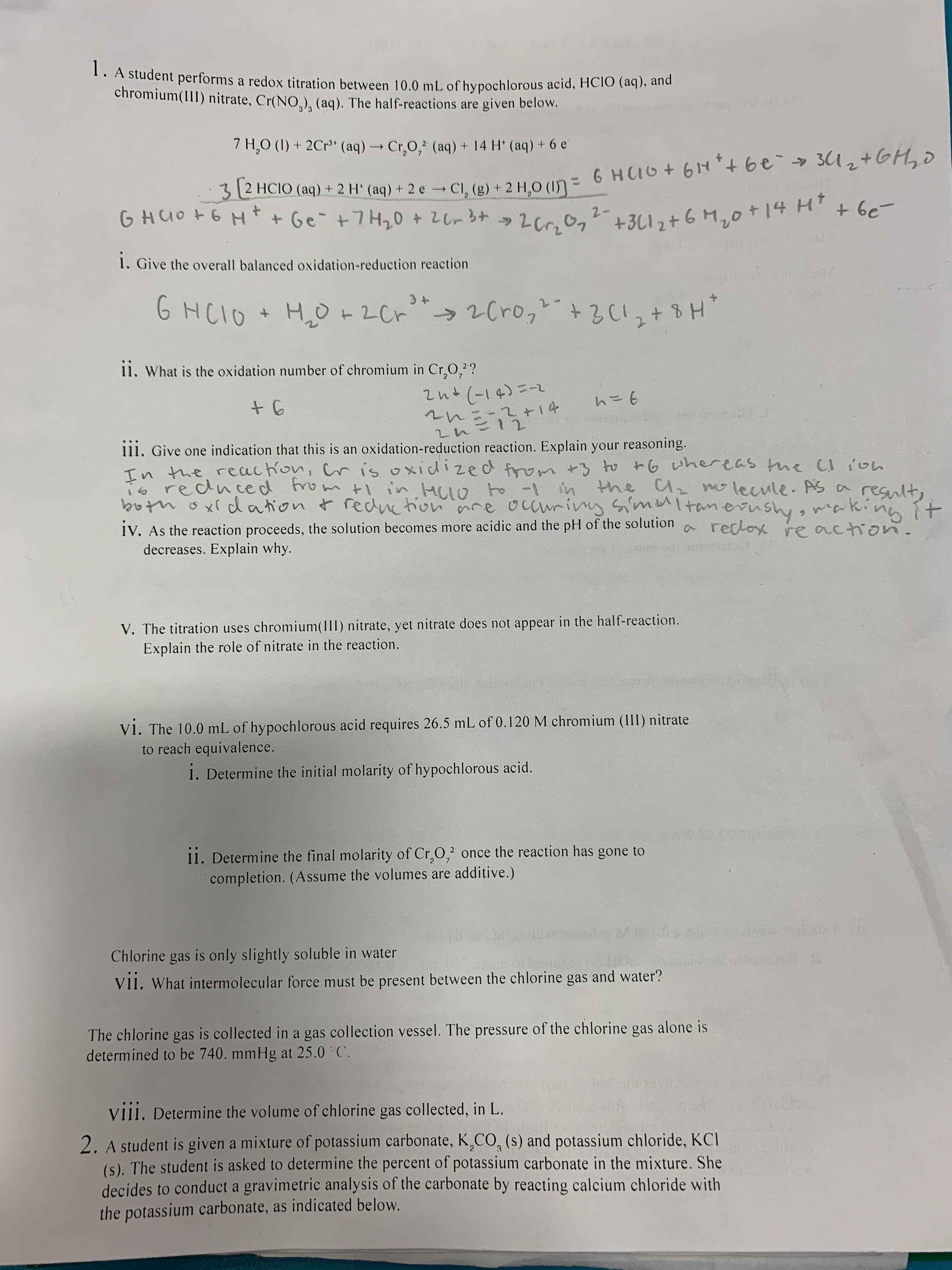ushy 1V. As the reaction proceeds, the solution becomes more acidic and the pH of the solution decreases. Explain why. a reclox re ac V. The titration uses chromium(III) nitrate, yet nitrate does not appear in the half-reaction. Explain the role of nitrate in the reaction. Vi. The 10.0 mL of hypochlorous acid requires 26.5 mL of 0.120 M chromium (III) nitrate to reach equivalence. 1. Determine the initial molarity of hypochlorous acid.
ushy 1V. As the reaction proceeds, the solution becomes more acidic and the pH of the solution decreases. Explain why. a reclox re ac V. The titration uses chromium(III) nitrate, yet nitrate does not appear in the half-reaction. Explain the role of nitrate in the reaction. Vi. The 10.0 mL of hypochlorous acid requires 26.5 mL of 0.120 M chromium (III) nitrate to reach equivalence. 1. Determine the initial molarity of hypochlorous acid.
Principles of Modern Chemistry
8th Edition
ISBN:9781305079113
Author:David W. Oxtoby, H. Pat Gillis, Laurie J. Butler
Publisher:David W. Oxtoby, H. Pat Gillis, Laurie J. Butler
Chapter11: Solutions
Section: Chapter Questions
Problem 26P
Related questions
Question
Hi, would you please mind answer questions 4, 5, and 6?

Transcribed Image Text:ushy
1V. As the reaction proceeds, the solution becomes more acidic and the pH of the solution
decreases. Explain why.
a reclox
re ac
V. The titration uses chromium(III) nitrate, yet nitrate does not appear in the half-reaction.
Explain the role of nitrate in the reaction.
Vi. The 10.0 mL of hypochlorous acid requires 26.5 mL of 0.120 M chromium (III) nitrate
to reach equivalence.
1. Determine the initial molarity of hypochlorous acid.
Expert Solution
This question has been solved!
Explore an expertly crafted, step-by-step solution for a thorough understanding of key concepts.
This is a popular solution!
Trending now
This is a popular solution!
Step by step
Solved in 2 steps

Knowledge Booster
Learn more about
Need a deep-dive on the concept behind this application? Look no further. Learn more about this topic, chemistry and related others by exploring similar questions and additional content below.Recommended textbooks for you

Principles of Modern Chemistry
Chemistry
ISBN:
9781305079113
Author:
David W. Oxtoby, H. Pat Gillis, Laurie J. Butler
Publisher:
Cengage Learning

Chemistry: Principles and Reactions
Chemistry
ISBN:
9781305079373
Author:
William L. Masterton, Cecile N. Hurley
Publisher:
Cengage Learning

Chemistry & Chemical Reactivity
Chemistry
ISBN:
9781133949640
Author:
John C. Kotz, Paul M. Treichel, John Townsend, David Treichel
Publisher:
Cengage Learning

Principles of Modern Chemistry
Chemistry
ISBN:
9781305079113
Author:
David W. Oxtoby, H. Pat Gillis, Laurie J. Butler
Publisher:
Cengage Learning

Chemistry: Principles and Reactions
Chemistry
ISBN:
9781305079373
Author:
William L. Masterton, Cecile N. Hurley
Publisher:
Cengage Learning

Chemistry & Chemical Reactivity
Chemistry
ISBN:
9781133949640
Author:
John C. Kotz, Paul M. Treichel, John Townsend, David Treichel
Publisher:
Cengage Learning

Chemistry
Chemistry
ISBN:
9781305957404
Author:
Steven S. Zumdahl, Susan A. Zumdahl, Donald J. DeCoste
Publisher:
Cengage Learning


Chemistry: An Atoms First Approach
Chemistry
ISBN:
9781305079243
Author:
Steven S. Zumdahl, Susan A. Zumdahl
Publisher:
Cengage Learning